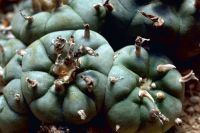Scarcity of peyote means hard times for dealers
 |
A large article from the Washington Post.
When the state of Texas licensed him as a peyote distributor in 1990, Mauro Morales put a sign in his front yard with his name and phone number: "Peyote Dealer. Buy or Sell Peyote."
His neighbors balked, saying calling so much attention to his trade had to be against the law. "So I called Austin and said, 'I think everything's legal. I've got the paperwork. Can't I put up a sign?'" Morales recalled.
Twenty years later, the sign still stands, but it's harder than ever for Morales to make a living. The hallucinogenic cactus is becoming more difficult to find because many ranchers have stopped allowing peyote harvesters on their land, preferring to plow the grayish-green plant under so cattle can graze. Others now lease their property to deer hunters or oil and gas companies.
The result is over-harvesting of remaining stocks, making peyote even more scarce. "Things are kind of getting slower every year," said Morales, who is one of just three Americans currently licensed to sell peyote, which grows wild in four Texas counties along the border with Mexico.
Peyote is illegal under federal law, except for use in some American Indian religious ceremonies. Since the mid-1970s, the state has licensed a small number of people to sell it to members of the Native American Church.
California voters recently rejected a proposal to legalize marijuana for recreational use, and a drug war threatens to tear Mexico apart. But Morales says his business is simple and honest.
"I try to stay out of problems," he said. "I've been doing it too long."
Morales, 67, has seven employees who search for peyote plants to harvest their "buttons," small round growths that contain the mind-altering juice mescaline, which produces a dreamlike delirium for up to 12 hours.
Users generally chew on the buttons, smoke them or boil them in water to make a drug-infused tea. The number of buttons it takes to feel psychedelic effects varies greatly by person and the potency of individual plants.
Morales' crews now bring in about 3,000 buttons per day, but even four years ago, it was 10,000. He began harvesting peyote at 14, when American Indian elders taught him to cut the buttons without harming the roots. Back then, each button could be sold to distributors for a nickel, but had to be at least as large as a half dollar.
Now Morales pays his harvesters 15 cents per button, no matter the size. "There are no more half dollar-sizes around," he said.
[Thanks Barnaby!]
|

Recently @ DoseNation
|
|






















The comments posted here do not reflect the views of the owners of this site.